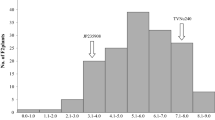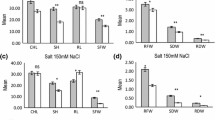Abstract
Most cultivars of tomato (Lycopersicon esculentum) are sensitive to salinity during seed germination and at later stages. Genetic resources for salt tolerance have been identified within the related wild species of tomato. The purpose of the present study was to identify quantitative trait loci (QTLs) for salt tolerance during germination in an inbred backcross (BC1S1) population of an interspecific cross between a salt-sensitive tomato breeding line (NC84173, maternal and recurrent parent) and a salt-tolerant Lycopersicon pimpinellifolium accession (LA722). Onehundred and nineteen BC1 individuals were genotyped for 151 restriction fragment length polymorphism (RFLP) markers and a genetic linkage map was constructed. The parental lines and 119 BC1S1 families (self-pollinated progeny of 119 BC1 individuals) were evaluated for germination at an intermediate salt-stress level (150 mM NaCl+15 mM CaCl2, water potential approximately −850 kPa). Germination was scored visually as radicle protrusion at 8-h intervals for 28 consecutive days. Germination response was analyzed by survival analysis and the time to 25, 50, and 75% germination was determined. In addition, a germination index (GI) was calculated as the weighted mean of the time from imbibition to germination for each family/line. Interval mapping, single-marker analysis and distributional extreme analysis, were used to identify QTLs and the results of all three mapping methods were generally similar. Seven chromosomal locations with significant effects on salt tolerance were identified. The L. pimpinellifolium accession had favorable QTL alleles at six locations. The percentage of phenotypic variation explained (PVE) by individual QTLs ranged from 6.5 to 15.6%. Multilocus analysis indicated that the cumulative action of all significant QTLs accounted for 44.5% of the total phenotypic variance. A total of 12 pairwise epistatic interactions were identified, including four between QTL-linked and QTL-unlinked regions and eight between QTL-unlinked regions. Transgressive phenotypes were observed in the direction of salt sensitivity. The graphical genotyping indicated a high correspondence between the phenotypes of the extreme families and their QTL genotypes. The results indicate that tomato salt tolerance during germination can be improved by marker-assisted selection using interspecific variation.
Similar content being viewed by others
Author information
Authors and Affiliations
Additional information
Received: 29 January 1998 / Accepted: 4 June 1998
Rights and permissions
About this article
Cite this article
Foolad, M., Chen, F. & Lin, G. RFLP mapping of QTLs conferring salt tolerance during germination in an interspecific cross of tomato. Theor Appl Genet 97, 1133–1144 (1998). https://doi.org/10.1007/s001220051002
Issue Date:
DOI: https://doi.org/10.1007/s001220051002




